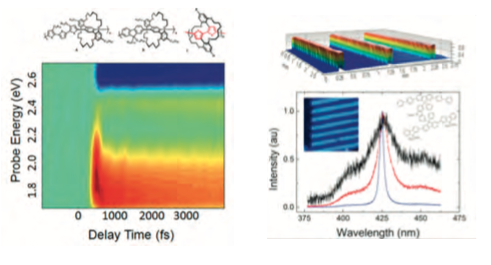We are actively working in position sensitive photodetectors based on organic semiconductors. This research line aims at developing organic photodetectors based on molecular multilayers, which deliver a linear change in photocurrent depending on the position of the impinging light on the pixel. We exploit optical interference in multilayer structures as well as antibatic photocurrent response to produce spatial tuning of photocurrent in one single pixel. [1][2][3] This idea is protected by a patent cooperation treaty (PCT) owned by IMDEA.[4] Based on this concept we have developed devices able to monitor lateral displacements in 1D [1,2] and 2D [5] with a spatial sensitivity in some of them close to 500 m [1].
 |
| Figure 1. (a) Vertical section of an organic position photodetector composed of two complementary donor-acceptor wedge layers. (b) Spectral response of the photodetector as a function of the position of the light spot along the pixel. Inset: Front view of the device. (c) Model of the penetration of the light across the different layers as a function of position along the pixel. (d) Calibration curve given by the linear variation of the photocurrent ratio at two wavelengths as a function of displacement. |
References:
[1] J. Cabanillas-Gonzalez et al., Appl. Phys. Lett. 99, 103305 (2011).
[2] J. Cabanillas-Gonzalez et al., J. Nanosci. Nanotechnol. 13, 1–6, (2013).
[3] M. Campoy-Quiles et al., Org. Photonics Photovolt.1, 11-23 (2013).
[4] J. Cabanillas-Gonzalez and M. Campoy-Quiles, PCT/ES2011/070841.
[5] X. Rodriguez-Martinez et al., submitted.






